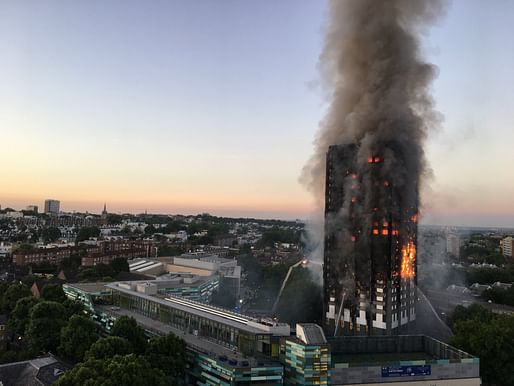anchor
RIBA submits evidence and recommendations to the Independent Review of Building Regulations and Fire Safety

Following the Grenfell Tower tragedy, the British government put out a call for evidence for the independent review of building regulations and fire safety. Led by Dame Judith Hackitt, the review will make recommendations to ensure there is a sufficiently robust regulatory system for the future, examining building and fire safety regulations and related compliance and enforcement with a focus on multi-occupancy high rise residential buildings.
Today, the RIBA has submitted its response and recommendations to the call. “The RIBA welcomes Dame Judith Hackett’s review but we believe it must be more comprehensive, addressing the details of Building Regulations guidance as well as the broader regulatory system. The Review should cover all building types and construction methods not just those relating to high-rise, multiple occupancy residential buildings. In addition to submitting evidence, the RIBA has also proposed a number of significant recommendations to the Review, to enhance the future fire safety of buildings for all residents and users” they added.
With that, the global professional membership body set out a series of initial recommendations, developed by the RIBA Expert Advisory Group on Fire Safety, for changes to Building Regulations and Fire Safety systems, regulations and guidance. They are proposing the following initial detailed recommendations to the Review:
- R1: Repeal of The Regulatory Reform (Fire Safety) Order 2005, under which building owners undertake their own fire risk assessment, and the re-introduction of mandatory Fire Certificates for designated premises, based on independent inspections by the fire brigades, with statutory powers of entry to individual dwellings where necessary.
- R2: An enhanced role for the fire brigades in assisting Building Control authorities in the fire risk assessment of Building Regulations Full Plans Applications for works involving higher risk buildings that will require mandatory fire certificates.
- R3: Review of the “stay put” policy in high-rise, multiple occupancy residential buildings, first introduced in British Standard Code of Practice CP3: Chapter IV (1962) Part 1: Fire Precautions in flats and maisonettes over 80ft in height. For new buildings, the RIBA has a preference for simultaneous evacuation, or phased/staged fire alarm systems, alternative means of escape options, and increased escape stair widths.
- R4: Introduction of a Building Regulations requirement for central fire alarm systems, with phased /staged capabilities, in multiple occupancy residential buildings.
- R5: Removal of the “desk-top” study approach to demonstrating compliance with Regulation B4.
- R6: Introduction of requirements for sprinklers/automatic fire suppression systems in all new and converted residential buildings, as currently required under Regulations 37A and 37B of the Building Regulations for Wales, or at least for residential buildings over three stories in height.
- R7: Introduction of a requirement for more than one means of vertical escape from new multiple occupancy residential buildings of more than three stories in height, and no use of compensatory features for omission of a staircase or alternative means of escape.
- R8: Review of the requirements for natural and mechanical smoke vent/exhaust provisions to corridors, lobbies and stairs to ensure current performance capacities are sufficient.
- R9: Development of clearer, prescriptive and design process driven guidance in Approved Document B, written in plain language with straight forward diagrams. Any test based solutions to be based on full scale fire testing and not use desktop studies.
- R10: External walls of buildings over 18m in height to be constructed of non-combustible (European class A1) materials only. (The Independent Review should also give detailed consideration to much greater restriction on the use of combustible materials and materials of limited combustibility in external wall construction more generally.) The RIBA believes that the Independent Review should also make recommendations in regard to ensuring the fire safety of the UK’s existing stock of high-rise, multiple occupancy residential buildings, and recommends:
- R11: Retro-fitting of central fire alarm systems in existing residential buildings over 18m in height.
- R12: Retro-fitting of sprinklers/automatic fire suppression systems to existing residential buildings over 18m in height, and perhaps extended to all existing residential buildings above three stories in height.
- R13: Consideration of the construction of alternative vertical means of escape, or escape safe havens/refuges, for residential buildings over 18m in height when there is currently only one staircase.
- R14: For new refurbishment projects involving “material alterations” to high-rise, multiple occupancy residential buildings, the retro-fitting of central fire alarm systems and sprinklers/automatic fire suppression systems should be mandatory.
This could be structured on a similar basis to the “consequential improvements” required under Part L of the Building Regulations to the energy performance of existing buildings where they are subject to renovation and/or extension.
The development of new materials and methods of construction and constantly evolving knowledge about the fire performance of buildings means that fire regulation needs to be regularly updated. The lack of a periodic timetable for updating of the Building Regulations Approved Documents, which has allowed review of Approved Document B to be almost indefinitely delayed, is highly problematic. - R15: The RIBA proposes that a formal, predetermined program for review of key Approved Documents should be adopted, as is the case with the Australian National Building Code. The CDM Regulations (Health and Safety) are reviewed every 5 years.
The full RIBA response to the call for evidence can be downloaded here.
Similar articles on Archinect that may interest you...

No Comments
Block this user
Are you sure you want to block this user and hide all related comments throughout the site?
Archinect
This is your first comment on Archinect. Your comment will be visible once approved.